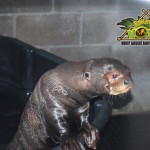UPDATE—WINNERS: Lucky 13…today has been declared official bloom date! Only guesses submitted by 2:00pm today June 13, 2012 will be taken in consideration. Email us at communications@moodygardens.com if we reply to your comment with “WINNER” to claim your prize. Thank you all for your guesses!
Morticia, the Corpse Flower, looks like she’s ready for her bloom! But without a set blooming season, it’s hard to predict when the Corpse Flower will bloom. So who “nose” when the Corpse Flower will bloom and begin its silent and smelly flowering? The first 20 people to guess correctly will win a free ticket to the Rainforest Pyramid to see Morticia!
A Corpse Flower bloom occurs when the spadix, the long, French bread-like stem, emerges from the bud. At that point, the flower will grow four to six inches a day and the strong smell will start to roll in. The strong smell that is similar to rotting flesh attracts its pollinators, carrion beetles and sweat flies. It is considered the largest flowering plant in the world, often reaching heights of over 10 feet tall. Technically, it is the largest unbranched inflorescence, containing both male & female flowers.
The Corpse Flower grows from an underground tuber which can weigh up to 200 pounds. From this tuber, a large single leaf emerges resembling a small tree that can grow to more than 20 feet tall. During this vegetative state, the tuber gains its energy to produce the massive bloom. The plant then goes into a dormant period for approximately three months. The tuber will then either produce another leaf or a flower as it has at Moody Gardens.
Once fully unfurled, the flower will only last for a day or two. Then the flower collapses upon itself and withers away. The tuber will then go into a dormant period, resting and gaining energy, eventually sending up another tree trunk-like stalk, beginning the incredible process all over again!
The Corpse Flower is under threat of extinction in the wild due to illegal logging and the clearing of rain forest land for cultivation of oil palm plantations. It is our hope that interest in and appreciation of our Earth’s amazing plants and animals will lead to increased efforts at conserving the habitats of these and other rare species.
CONTEST RULES:
Use the information we’ve provided above as well as Morticia’s growth progress, which we update frequently on our Facebook & Twitter, to guess the exact date that she will bloom. Our horticultural exhibit manager, Donita Brannon, will declare the official bloom date. Here are the rules:
- Leave your guess in the comments section of this post or tweet us your guess @Moody_Gardens with hashtag #MorticiaContest
- Only one guess per person.
- Contest open until flower starts to bloom
- First 20 people to guess correctly will win two (2) tickets to the Rainforest Pyramid®
- Only people who guess the EXACT date determined by our horticultural exhibit manager will win
While you’re at it, why not go ahead and like us on Facebook and/or follow us on Twitter.
This promotion is in no way sponsored, endorsed or administered by, or associated with, Facebook, Inc. Any comments that are inappropriate, offensive, spam or commercial in nature can be deleted by the page admin. Must be 18 years or older to win.





